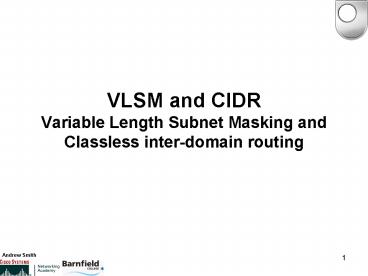VLSM and CIDR Variable Length Subnet Masking and Classless interdomain routing
1 / 17
Title:
VLSM and CIDR Variable Length Subnet Masking and Classless interdomain routing
Description:
The subnet mask is 32 bits, remember the dotted notation is only to make the ... as the desired outcome is to create an address and subnet mask ... –
Number of Views:1137
Avg rating:3.0/5.0
Title: VLSM and CIDR Variable Length Subnet Masking and Classless interdomain routing
1
VLSM and CIDRVariable Length Subnet Masking and
Classless inter-domain routing
2
VLSM and CIDR
This session will extend your understanding of
sub-networking and explore address
aggregation This session summarises pack 2 on
the OU T228 eDesktop site
3
VLSM and CIDR
- Whilst IPv4 is 32 bit and offers over 4 billion
addresses, severe restrictions now exist - Companies may have public address space that is
reaching saturation - The loss of the broadcast subnet is considered
wasteful - VLSM (Variable Length Sub-Net Masking) has two
advantages - - It extends the hierarchical structure of the
network addressing scheme - Allows you to retrieve wasted addresses and apply
them to suitable hosts
4
VLSM and CIDR
5
VLSM and CIDR
- The basic rules for VLSM are exactly the same as
those for sub-networking, - You can only borrow (subdivide) from the host
portion of the subnet in question - You can only have even numbers of variable
sub-networks - Binary 1s are always to the left, there are no
exceptions for VLSM - Binary 0s are always to the right, again there
are no exceptions - Binary 1s always represent the number of
sub-networks - Binary 0s always represent the number of hosts
in each variable sub-network - Borrowing is done with a 1, each 1 means that you
double the number of sub-networks. - The subnet mask is 32 bits, remember the dotted
notation is only to make the information
understandable to humans.
6
VLSM and CIDR
An easy VLSM example! Create a subnet mask for
100.0.0.0 which will ensure it has 1500
sub-networks 100 .0 .0 .0 11111111 .11111111 .
11100000 .00000000 255 .255 .224 .0 It is
class A You must have 2048 sub-networks
7
VLSM and CIDR
- An easy VLSM example!
- Create a subnet mask for 100.0.0.0 which will
ensure it has 1500 sub-networks - Now we want the 100th sub-network
- And yes we are going to use subnet 0 (TMA tip,
declare it, use it) - So we have the network id of 99 for the 100th
sub-network (count from 0-99, is 100 networks) - 99 in binary is 01100011
- Place it on the right hand side
- 100 .0 .0 .0
- 11111111 .11111111 .11100000 .00000000
- .00001100 .01100000 .00000000
- 100 .12 .96 .0
- Is our elected subnet
8
VLSM and CIDR
An easy VLSM example! We have created a subnet
mask for 100.0.0.0 which will ensure it has 1500
sub-networks Now we want 100 sub-networks within
the 100th subnet So we simply start from our new
position 100 .0 .0 .0 100 .12 .96 .0 255 .2
55 .224 .0 11111111 .11111111 .11100000 .0000000
0 11111111 .11111111 .11111111 .11000000 255 .25
5 .255 .192 With 62 (64-2) hosts per subnetwork
9
VLSM and CIDR
You must be aware, you can VLSM to the Nth degree
and VLSM a subnetwork that has already been
Variably Length Subnet Masked until you run out
of discrete addresses
10
VLSM and CIDR
- VLSM problems
- With 99.0.0.0
- Create a subnet mask for 100 sub-networks
- Find the 50th (subnet 0 may be assumed)
- Create a subnet mask for a further 50
sub-networks - Now find the 25th
- Create a subnet mask for a further 10
sub-networks - With 200.0.0.0
- Create a subnet mask for 5 sub-networks
- What is the last sub-network?
- How many VLSM sub-networks can be fitted into
this space
11
VLSM and CIDR
- CIDR (Classless Inter Domain Routing)
- Commonly referred to as supernetting
- Is used to summarise a range of network addresses
into one routing table entry - Reduces the size of a routing table
- Reduces the updates on the inter router link
- Creation of one aggregate address
- Is not an exact science, which means we can have
more than one answer to the same problem
12
VLSM and CIDR
CIDR (Classless Inter Domain Routing)
13
VLSM and CIDR
CIDR (Classless Inter Domain Routing)
- The process of supernetting is considerably
simpler than sub-networking, - as the desired outcome is to create an address
and subnet mask - which summarises a range of known (and previously
sub-networked) - network addresses.
- To calculate a supernet address, you have to -
- Line up all the network addresses
- Compare the binary
- Find the common bit!
- Calculate the new aggregate address and mask
based on the common bit, - and that which is to the left of it
14
VLSM and CIDR
CIDR (Classless Inter Domain Routing)
15
VLSM and CIDR
CIDR (Classless Inter Domain Routing) CIDR
Exercise For 80.16.10.0 80.16.20.0 80.16.30.0
80.16.40.0 80.16.50.0 Find a suitable summary
address
16
VLSM and CIDR
CIDR (Classless Inter Domain Routing) CIDR
Exercise For 80.16.0.0 80.26.0.0 80.56.0.0 80.
66.0.0 80.76.0.0 Find a suitable summary address
17
VLSM and CIDR
Additional Exercise?































